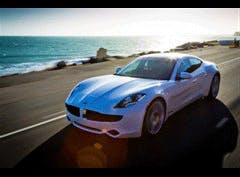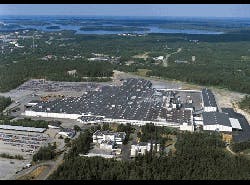Much to the automaker’s dismay amid signing several new sought-after agreements expanding its international network of sales and service outlets, Fisker’s Finnish manufacturing presence has factored into the hard-fought campaign for president of the United States.
Like this article? Sign up for our enews blasts here.
The political dustup originated with a television commercial by Mitt Romney accusing the Barack Obama administration of diverting federal stimulus funds for “electric cars from Finland.”
Shortly after the ad launched – perhaps you’ve seen it airing on your local TV station – Republican National Committee Chairman Reince Priebus upped the ante by declaring that “President Obama took half a billion dollars of your taxpayer money and gave it to Fisker Automotive because they promised to create jobs at their Wilmington plan. But they didn’t create jobs for you. Their factory in Delaware…was supposed to be open today, but instead it’s closed. And Fisker is still building their cars in Finland.”
Entering the fray soon after was PolitiFact, a consortium of journalists who take a non-partisan approach to reviewing the veracity of various claims made by public figures. In a lengthy analysis, PolitiFact’s Jon Greenberg rendered a rating of “false” on the Truth-O-Meter, concluding that no government funds have ended up in Finland.
Greenberg also points out that the money in question has nothing to do with Obama’s stimulus plan. Instead the Fisker funds under discussion are in the form of a loan through the U.S. Department of Energy’s (DOE) Advanced Technology Vehicles Manufacturing program. The legislation establishing the effort was signed into existence by former President George W. Bush in 2007.
Fisker applied for the program during the Bush administration, with Obama’s administration granting final approval for a $528 million loan. Thus far, the DOE has released only $193 million of that amount pending Fisker’s following through with expanded production at the Delaware facility, a 3.2 million square-foot former General Motors plant that Fisker bought in 2010 for $20 million.
“This is a major step toward creating thousands of manufacturing jobs and restoring America as a leader in the global auto industry,” says Bernhard Koehler, chief business development officer. “Wilmington will be instrumental in fulfilling our plans to export more than half of Fisker premium plug-in hybrid production to global markets.”
“Launching a new car company is a difficult enough challenge on its own and one that is rarely attempted, let alone also trying to establish a new brand with a revolutionary new product and technology,” says Henrik Fisker, the company’s founder, executive chairman and chief designer. “We have made steady progress and won several prestigious awards for our game-changing Karma model, but changing the market is never a risk-free enterprise. We have faced multiple challenges, which have created skepticism about our ambitions – especially in uncertain economic times. But we are building a business for the future by pursuing sustainable luxury without compromise.”
There are currently more than 100 workers reconfiguring the Delaware plant “so that Fisker will be ready to begin hiring a skilled hourly workforce to producing its Nina platform vehicles in the U.S. for sale around the world,” according to Fisker. “Many of these Delaware costs are covered by the DOE loans. For the Karma program, the DOE loan money was used solely in the U.S. to fund design, engineering and integration work.”
Private equity financing, amounting to more than $600 million, has been used for costs not covered by the DOE, and only a small portion is spent on production in Finland, he says.
“The majority of our private funding has been used to create jobs, including 650 people at Fisker’s headquarters in California, over 100 at the Delaware plant and many more at various suppliers throughout the U.S.,” Fisker asserts.
More than 45 percent of the Karma’s components are manufactured by 40 suppliers located in the U.S. Some of the key American vendors include A123 Systems for the lithium-ion battery; GM’s Springhill Engine Plant, which manufactures the gasoline motor; Goodyear supplies the tires; and TRW produces the regenerative braking system, according to Fisker.
In early August, Tony Posawatz, former head of GM’s Volt program, was selected as the company’s new CEO. He replaces Tom LaSorda in a planned succession. “Tony is the perfect CEO for Fisker. He has been at the forefront of the industry’s technological revolution and one of the few people in the world to bring an EV to mass production,” LaSorda says. “Part of my assignment at Fisker was to recruit a long-term CEO, and I cannot think of a better person than Tony to take us forward. He is a real product guy for a product-driven company.”
“In the long-term he will ensure that Fisker is well positioned to maximize the potential of not only the Karma sedan, but also bring the Fisker Atlantic smoothly to market,” notes Fisker.
In June the company partnered with the Penske Automotive Group to sell and service its vehicles in Arizona and the surrounding region, bringing the dealership total up to 80 locations in the U.S., Canada and Europe.
“Our research shows there is strong demand for clean, energy-efficient luxury cars,” reports Dave Wallace, a Penske vice president.
“Their support speaks volumes about Fisker’s market potential,” observes Matthew Malfitano, Fisker’s director of North American operations. There are 48 outlets in North America, with plans to distribute the Karma in China and the Middle East following new retail agreements in both regions.
Fisker of Montreal, the company’s first dealership in Quebec and the fourth in Canada, is another recent addition to the sales and service network. Formed by Gad Bitton, president of the Holand Automotive Group, and Norman Hébert, president and CEO of Groupe Park Avenue, the two entities market a combined 17 nameplates in multiple locations across Montreal, including Rolls Royce, Lamborghini, BMW and Lexus.
Word came in May from the Netherlands that Fisker had surpassed BMW, Mercedes and Audi to become the No. 2 top selling offering in the segment for high-end, four-door models during the first quarter of the year. Second in sales only to the Porsche Panamera, “it is thought to be the first time that an ultra-low emission hybrid car has outsold combustion engine rivals,” according to LaSorda.
“This is a great achievement for Fisker and signals the potential demand in Europe, where we intend to sell 40 percent of our output,” LaSorda says. “It is an encouraging sign of progress following the Karma launch. But we have much more to do as we bring new models to market.”
For more information, visit www.fiskerautomotive.com.



